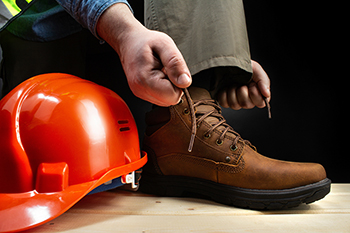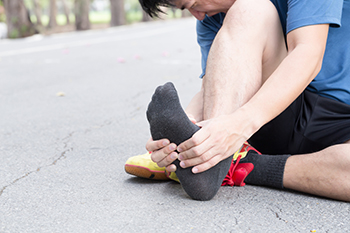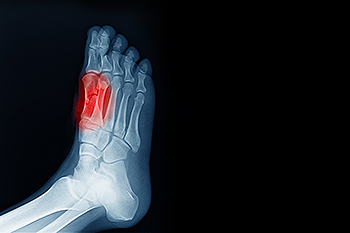Items filtered by date: December 2023
Types of Workplace Foot Injuries

Studies have shown the majority of workplace related injuries that affect the feet are punctures, crushing, sprains, lacerations, slips, trips, and falls. Stepping on nails, shards of glass, or other sharp objects can result in puncture wounds to the feet. These injuries can be particularly dangerous, as they can introduce bacteria into the body, possibly leading to infections. Sharp tools and equipment can cause lacerations to the feet, resulting in bleeding and the risk of infection. Slips and falls can be attributed to wet floors, cluttered walkways, or uneven surfaces. When an employee falls, the feet are often the first point of contact with the ground, making them susceptible to injuries such as fractures, sprains, and bruises. Standing for extended periods of time on hard flooring, combined with wearing ill fitting shoes, can lead to foot fatigue. Fatigue can set employees up for further injuries and decrease their alertness. The main way to avoid many of these types of injuries is by wearing protective footwear appropriate for the type of work environment. If you need help managing foot conditions that result from work related injuries, it is suggested that you consult a podiatrist.
While working on the feet, it is important to take the proper care of them. For more information about working on your feet, contact one of our podiatrists from Ankle & Foot of Edmonds. Our doctors will treat your foot and ankle needs.
Working on Your Feet
Standing on your feet for long periods of time can cause stress and pain in your feet. Your whole body may experience change in terms of posture, back pain, bunions, callouses and or plantar warts. There are ways to avoid these conditions with proper foot care, smart choices and correct posture.
Positive Changes
Negative heeled shoe – Choosing this shoe type places the heel slightly lower than the ball of the foot. These are great for overall foot health. Find shoes that fit you correctly.
Go barefoot – Our feet were not designed to be enclosed for all hours of the day. Try to periodically expose your feet to air.
Eliminate Pain
Foot Exercises – Performing simple exercises, incorporating yoga and doing stretches are beneficial. This will allow increased blood flow to the area and muscles of the foot.
Achilles tendon – Stretching the foot out flat on the floor will relax the calf muscles and tendon. These exercises can be performed almost anywhere. Make sure you add these exercises to your daily regimen.
With a little bit of this information and knowing more about foot health, you will notice changes. Foot stretches and proper footwear will help with pain and prevent further issues.
If you have any questions please feel free to contact our office located in Edmonds, WA . We offer the newest diagnostic and treatment technologies for all your foot and ankle needs.
Symptoms of Plantar Fibromatosis

Plantar fibromatosis is an uncommon condition that affects the tissue on the bottom of the foot. It is not cancerous, but it causes the tissue to overgrow. To diagnose it, podiatrists look for lumps in the middle or inside part of the tissue on the bottom of your foot. Those individuals suffering from plantar fibromatosis generally notice it when it starts to hurt and swell in the inside part of their foot. If you have these types of symptoms, it is suggested that you schedule an appointment with a podiatrist for a proper diagnosis and appropriate treatment plan.
A plantar fibroma may disrupt your daily activities. If you have any concerns, contact one of our podiatrists of Ankle & Foot of Edmonds. Our doctors can provide the care you need to keep you pain-free and on your feet.
Plantar Fibroma
A plantar fibroma is a fibrous knot in the arch of the foot. It is embedded in the plantar fascia which is a band of tissue that extends from the heel to the toes along the bottom of the foot. There can be multiple plantar fibromas in the feet at the same time. There are no known causes for this condition. If you have a plantar fibroma, there will be a bump in the arch of your foot that cannot be missed. Any associated pain is most often due to a shoe rubbing against the nodule. Non-surgical options, such as steroid injections, physical therapy, and orthotics should be tried first. Surgery is a last resort and is the only thing that will remove a plantar fibroma entirely. Consult with a podiatrist for a proper diagnosis and to determine the treatment regimen that is right for you.
What Causes a Plantar Fibroma?
While there are no specific causes identified, a plantar fibroma can possibly come from genetic predisposition or the formation of scar tissue that forms from healing the tears in the plantar fascia.
What Are the Symptoms of a Plantar Fibroma?
There will be a noticeable lump in the arch of the foot that may or may not cause pain. If pain is felt, it is typically because a shoe is rubbing up against the lump or when walking or standing barefoot.
Treatment and Prevention
A plantar fibroma will not disappear without treatment, but it can get smaller and be a non-issue. If pain persists, a podiatrist examines the foot and when the arch of the foot is pressed, pain can be felt down to the toes. An MRI or biopsy might be performed to help diagnose or evaluate the plantar fibroma. The following non-surgical options are generally enough to reduce the size and pain of these nodules:
- Steroid injections
- Orthotics
- Physical therapy to help apply anti-inflammatory creams on the bump
Surgery is considered if the mass increases in size and the patient continues to feel pain after non-surgical methods are tried.
If you have any questions please feel free to contact our office located in Edmonds, WA . We offer the newest diagnostic tools and technology to treat your foot and ankle needs.
The Function of the Sesamoid Bones in the Feet

Sesamoid bones are tiny bones that are found near joints within muscles or tendons. They act like pulleys to reduce stress on these muscle-tendon areas. Unlike regular bones that connect at joints, sesamoid bones connect to muscles using tendons. The word sesamoid comes from the Arabic word sesamum, which means sesame, because they are small like sesame seeds. These bones are often in the foot, hand, and wrist. Sesamoid bones usually develop due to extra strain on muscles and tendons. Their main job is to ease tension in muscles and tendons, making them better at carrying weight and more resilient by distributing it evenly. This helps protect these various parts of the body from getting too strained or injured. Even though they are small, sesamoid bones are vital in how our bodies work. If you have pain in your feet corresponding to the location of these bones, it is suggested that you schedule an appointment with a podiatrist for a proper diagnosis and treatment
Sesamoiditis is an unpleasant foot condition characterized by pain in the balls of the feet. If you think you’re struggling with sesamoiditis, contact one of our podiatrists of Ankle & Foot of Edmonds. Our doctors will treat your condition thoroughly and effectively.
Sesamoiditis
Sesamoiditis is a condition of the foot that affects the ball of the foot. It is more common in younger people than it is in older people. It can also occur with people who have begun a new exercise program, since their bodies are adjusting to the new physical regimen. Pain may also be caused by the inflammation of tendons surrounding the bones. It is important to seek treatment in its early stages because if you ignore the pain, this condition can lead to more serious problems such as severe irritation and bone fractures.
Causes of Sesamoiditis
- Sudden increase in activity
- Increase in physically strenuous movement without a proper warm up or build up
- Foot structure: those who have smaller, bonier feet or those with a high arch may be more susceptible
Treatment for sesamoiditis is non-invasive and simple. Doctors may recommend a strict rest period where the patient forgoes most physical activity. This will help give the patient time to heal their feet through limited activity. For serious cases, it is best to speak with your doctor to determine a treatment option that will help your specific needs.
If you have any questions please feel free to contact our office located in Edmonds, WA . We offer the newest diagnostic and treatment technologies for all your foot and ankle needs.
Plantar Warts Can Be Treated!
Does Obesity Affect the Feet?

Obesity, a condition affecting millions globally, extends its impact beyond mere aesthetics, significantly influencing the health of the feet. The excess body weight borne by the feet places immense stress on the joints, tendons, and ligaments, potentially leading to a range of foot-related issues. One prevalent consequence is the development of flat feet or fallen arches, as the increased load alters the foot's biomechanics. Overpronation, where the foot rolls inward excessively, is also a common occurrence, contributing to conditions such as plantar fasciitis and Achilles tendonitis. The risk of stress fractures in the feet also rises due to the heightened strain on bones. Obesity may exacerbate existing conditions such as arthritis, causing increased pain and limited mobility. Additionally, the increased pressure on the plantar fat pad may lead to discomfort and pain in the heel and ball of the foot. Addressing obesity not only benefits overall health but also plays a pivotal role in mitigating the potential foot-related complications associated with carrying excess weight. If you are overweight and have foot pain, it is suggested that you consult a podiatrist who can monitor your foot health.
Obesity has become very problematic at this point in time and can have extremely negative effects on the feet. If you’re an obese individual and are concerned about your feet, contact one of our podiatrists from Ankle & Foot of Edmonds. Our doctors can provide the care you need to keep you pain-free and on your feet.
Obesity and Your Feet
Since your feet are what support your entire weight when standing, any additional weight can result in pain and swelling. Being overweight is one of the main contributors to foot complications.
Problems & Complications
Extra Weight – Even putting on just a few extra pounds could create serious complications for your feet. As your weight increases, your balance and body will shift, creating new stresses on your feet. This uneven weight distribution can cause pain, even while doing the simplest tasks, such as walking.
Diabetes – People who are overweight are at serious risk of developing type-2 diabetes, which has a drastic impact on the health of your feet. As you get older, your diabetes might worsen, which could lead to loss of feeling in your feet, sores, and bruises. You could also become more prone to various infections.
Plantar fasciitis – Pressure and stress that is placed on muscles, joints, and tendons can trigger plantar fasciitis, which is an inflammation of tissue that forms along the bottom of the foot.
If you have any questions please feel free to contact our office located in Edmonds, WA . We offer the newest diagnostic and treatment technologies for all your foot and ankle needs.

